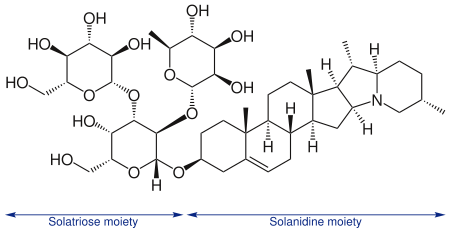Glycoalkaloid
Glycoalkaloids are a family of chemical compounds derived from alkaloids in which sugar groups are appended. There are several that are potentially toxic, most notably those which are the poisons commonly found in the plant species Solanum dulcamara (nightshade).[1]
A prototypical glycoalkaloid is solanine (composed of the sugar solanose and the alkaloid solanidine), which is found in potato. The alkaloidal portion of the glycoalkaloid is also generically referred to as an aglycone. The intact glycoalkaloid is poorly absorbed from the gastrointestinal tract but causes gastrointestinal irritation. The aglycone is absorbed and is believed to be responsible for observed nervous system signs.
Glycoalkaloids are typically bitter tasting, and produce a burning irritation in the back of the mouth and side of the tongue when eaten. The Aymara people of Bolivia use taste to detect the levels of glycoalkaloids in potatoes to determine the safety of various cultigens.[2]
Although not routinely available, detection of alkaloids in tissues or urine is possible for laboratory diagnosis of exposure.[3]
Sale of a glycoalkaloid-based treatment marketed by Lane Labs USA Inc. for prevention of skin cancer was banned by the FDA in 2004 as an unapproved drug.[4] Similar glycoalkaloid gels are now marketed as exfoliants.[5]

References
- ↑ http://cal.vet.upenn.edu/poison/plants/slides/2102lg.jpg Archived June 22, 2006, at the Wayback Machine.
- ↑ Johns, T., Keen, S.L. (1986). "Taste evaluation of potato glycoalkaloids by the Aymara: A case study in human chemical ecology". Human Ecology. 14 (4): 437–452. doi:10.1007/bf00888308.
- ↑ http://cal.vet.upenn.edu/poison/plants/ppeurop.htm Archived June 16, 2007, at the Wayback Machine.
- ↑ fda.gov, news item 1086 Archived October 7, 2006, at the Wayback Machine.
- ↑ outletnutrition.com, sunspesexsua Archived October 20, 2006, at the Wayback Machine.